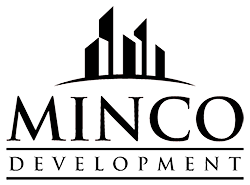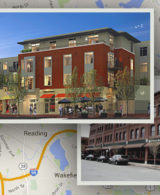Your top 10 questions about One Boston Way

Over the past several weeks, we’ve detailed the ins and outs of Smart Growth zoning and our related proposal, One Boston Way. Do you want to learn more? Take a look at the answers to these 10 common questions:
- What does 40R mean?
Chapter 40R of the Massachusetts General Laws is more commonly known as Smart Growth zoning. Enacted in 2004, it promotes compact design, transit-oriented and walkable neighborhoods, a mix of both commercial and residential development, a range of housing opportunities, the preservation of open space, and efficient land use. In other words, 40R is designed to avoid all the issues associated with urban sprawl and cookie-cutter development. It also provides direct cash payments to cities and towns that create Smart Growth Zoning Overlay Districts that meet all the requirements of the statute. Besides a zoning incentive payment of up to $600,000, localities qualify for a density bonus of $3,000 per unit. (Read our first post on the basics of Smart Growth zoning here.)
- What is One Boston Way?
One Boston Way is the name of MINCO’s proposed Smart Growth development in an underutilized parking lot off Parker Street by the MBTA Rail Station, a location identified as ideal for Smart Growth in the 2014 Master Plan. As presently contemplated, it includes 80 apartments and 3,500 square feet of shared work space and live-work units. Twenty-five percent of the units will be designated affordable, meaning they are reserved for families or individuals who earn no more than 80 percent of the area-wide median income. The parcel includes 11 acres, nine of which will be preserved as open space. Learn more about One Boston Way by reading our post about the details of the proposal.
- Where is the Smart Growth district and why does Newburyport need one?
The proposed district stretches from the lower part of State Street, across the Route 1 rotary, to an underutilized parking lot off Parker Street near the MBTA Rail Station and the area around Haley’s Ice Cream (take a look at this map). A Smart Growth district comes with a myriad of benefits for Newburyport (Read our post, “How Newburyport Stands to Benefit from a Smart Growth District”). To name a few, it increases housing options by growing the city’s stock of rental units and affordable housing; it provides financial incentives from the state; it increases the tax base; it lets the city maintain control over the location as well as the design of any development; it helps the city capitalize on a demographic shift in housing preferences among Millennials and Baby Boomers; it promotes the creation of the increasingly popular live/work spaces; and it solidifies the city’s reputation as a walkable, vibrant community.
- Who will pay for the cost of educating children who move into the district?
In accordance with Chapter 40S, the state reimburses cities and towns for the additional cost of educating school-age children living in new housing in Smart Growth districts. The legislation was enacted specifically to address concerns about the imbalance of tax revenues and service costs.
- How much will the city gain in revenue from the Smart Growth District and new taxpayers?
The exact figures have yet to be determined, but once constructed and fully occupied One Boston Way will boost city finances since the site is currently owned by the MBTA and, as such, contributes no local tax dollars.
- Why does the building include shared workspace?
Shared workspace near transit centers is increasingly popular in urban areas of eastern Massachusetts among, for example, accountants, lawyers, and salespeople. A portion of the first floor of One Boston Way will be devoted to shared office space modeled after the concepts of the Cambridge Innovation Center and WeWork that bring together innovative professionals from a range of industries. The city also indicated it would like to see mixed use on the site.
- What is the plan for the rest of the district?
The proposed Smart Growth district is divided into three sub-districts that wrap around the Route 1 traffic circle. One Boston Way is the first development being proposed within the district borders. Any other proposals will be brought to attention of the Planning Board and need the board’s approval to move forward. The Smart Growth designation paves the way for residential and mixed use development. (Find out how other communities have applied Smart Growth zoning here).
- Is the idea of a Smart Growth district in Newburyport new?
No, both the 2001 Master Plan and the new 2014 Master Plan focus on the need to establish a Smart Growth district in Newburyport. The 2014 plan even includes a stated desire to create a Smart Growth Zoning Overlay District near the MBTA Commuter Rail station as part of an effort to revitalize the area around the Route 1 rotary. If there’s one idea that runs through all the chapters of the Master Plan, it is Smart Growth, said Planner Kate Newhall-Smith when we spoke to her earlier this spring. In a series of public meetings about the content of the Master Plan, the public also voiced support for the Smart Growth concept. (Read more about this topic here.)
- Will any of the affordable units be subsidized?
No, no affordable units will be subsidized. The affordable designation means the units will be reserved for individuals or families who make 80 percent or less of the area-wide median income which is issued annually by HUD.
- When will construction begin?
Before MINCO can move ahead with the proposed One Boston Way, the Smart Growth district needs City Council approval. However, the city must first submit the Smart Growth application to the state Executive Office of Housing and Economic Development for review. A public hearing, held May 6, was continued to June 17. As soon as the review has been completed and the public hearing has taken place, the ordinance will head to the City Council for a final vote. Upon approval, MINCO can close on the property and start the permitting process. Construction is likely to begin within 6 to 12 months of the final approvals by the Planning Board and Conservation Commission, and the expiration of all appeals periods.



